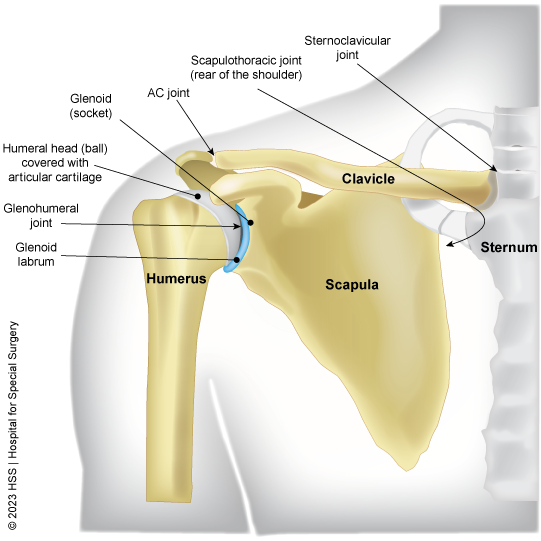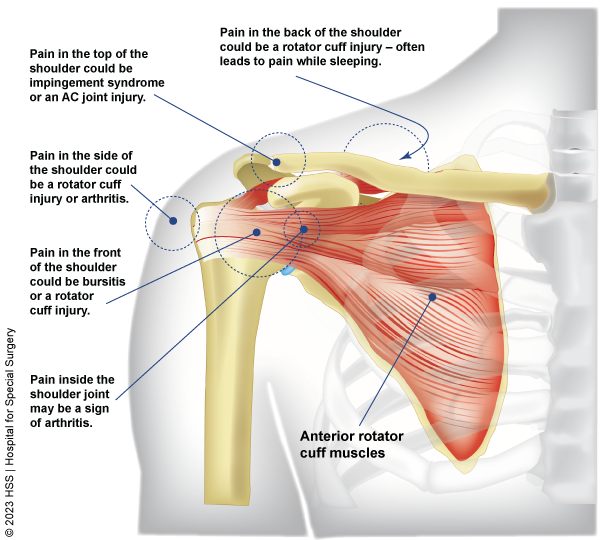Shoulder Pain Causes, Conditions and Treatments
The shoulder has the widest range of motion of all the joints in the body, but this flexibility comes at the cost of stability. It is the most commonly dislocated joint in the body and is prone to injuries that cause pain. Below, we review common causes of shoulder pain.
Shoulder anatomy overview
The shoulder comprises three bones – the humerus (upper arm), the scapula (shoulder blade), and the clavicle (collarbone) – which form four joints:
- The glenohumeral joint is a ball-and-socket joint. The humeral head at the top of the humerus (upper arm bone) is the rounded ball that meets the socket, called the glenoid, which lies on the side of the scapula (shoulder blade).
- The sternoclavicular joint, at the top of the chest, connects the sternum (breastbone) with the clavicle (collarbone).
- The acromioclavicular joint (AC joint) is where the acromion (the upper rear tip of the scapula) meets the clavicle.
- The scapulothoracic joint is where the scapula glides across the rib cage in the back of the shoulder.

Illustration of the shoulder bones and labrum
Compared to the deep socket of the hip joint, the glenoid is shallow, like a golf tee. The shoulder, therefore, relies on several soft tissue structures to keep the joint's “golf ball” in place:
- The joint capsule is a thick, fibrous membrane that protects the joint and produces synovial fluid to nourish it.
- The labrum is a specialized layer fibrocartilage that lines the socket.
- Ligaments connect the shoulder bones and reinforce the joint structure.
- Tendons attach the muscles to the bones. A group of four muscles known as the rotator cuff envelops and stabilizes the joint, and facilitates movement. Bigger, surrounding muscles like the deltoid and trapezius facilitate heavy lifting.
Where is your shoulder pain?
Shoulder pain can arise from conditions inside the joints, in muscles or tendons, or from problems unrelated to the shoulder such as spine problems or heart conditions. Shoulder pain that is related to structures outside the shoulder is called referred pain. Because of the complex neural pathways that allow us to sense pain, the location of pain does not always precisely correlate with the tissue that is injured. Rotator cuff injuries, especially, may cause pain in a variety of areas.
A skilled practitioner often can diagnose a shoulder injury based on the description and location of pain or other symptoms, along with a physical exam. Often, radiological imaging (X-ray, ultrasound and/or MRI) is beneficial to further evaluate a joint injury.
Locations of shoulder pain
Pain in a particular area of the shoulder can indicate that you have a specific type of injury or condition.

Shoulder pain diagnosis chart
- Pain in the front of the shoulder may indicate shoulder tendonitis, bursitis or a rotator cuff injury, frozen shoulder.
- Pain in the top of the shoulder may indicate shoulder impingement syndrome, rotator cuff injury, acromioclavicular (AC) joint injuries.
- Pain in the side of the shoulder may indicate rotator cuff injuries, frozen shoulder, osteoarthritis.
- Pain in the back of the shoulder may indicate a rotator cuff injury or scapular dyskinesis (abnormal movement of the shoulder blade).
- Diffuse shoulder pain, or pain in multiple locations, may indicate rotator cuff injuries or glenohumeral arthritis.
Pain and other symptoms in or around the shoulder
Pain and/or or movement restriction inside or near the shoulder can also suggest particular conditions, which should be diagnosed by a physician.
Pain inside the shoulder joint
Pain inside the joint may be a sign of arthritis, which is damage to the joint's protective cartilage. Osteoarthritis, degenerative wear-and-tear of the joints as people age, is the most common type of arthritis to affect the shoulder. Less often, inflammatory diseases like rheumatoid arthritis can cause cartilage damage.
The most common symptoms of shoulder arthritis are pain and stiffness of the joint. Pain can be present in the front, side and/or back of the shoulder. Pain may occur whether you are using your shoulder or not, but it is generally worse when lifting or carrying heavy objects, exercising, or reaching overhead.
In some arthritis cases, a feeling of clicking or cracking of the shoulder joint can accompany the pain. However, clicking of the shoulder may be present even in people with no pain.
Shoulder pain with restricted movement – frozen shoulder, impingement, and bursitis
Significantly restricted movement beyond the stiffness associated with arthritis may be a sign of frozen shoulder, also known as adhesive capsulitis. This condition occurs when connective tissue surrounding the shoulder joint known as the joint capsule becomes inflamed, causing it to thicken and contract. Early on, this presents with pain similar to a rotator cuff injury, however in most cases there is no specific injury. Eventually, the shoulder motion becomes more limited often in conduction with pain. Eventually, frozen shoulder will “thaw,” allowing for a return to normal movement and strength, as well as less pain.
Pain and stiffness of the shoulder caused by an irritation of one or more tissues is sometimes collectively called shoulder impingement. Impingement refers compression or rubbing between bone, tendon and/or the shoulder bursa – a fluid-filled sac that cushions the area between tendons and bone. Inflammation of the bursa caused by an impingement is known as shoulder bursitis.
Pain around the shoulder blade
Pain around the shoulder blade can be caused by tendonitis or muscle tears that occur due to overuse of the shoulder, such as from sports or work-related strain. The pain that occurs due to overuse often starts in the muscles of the shoulder and can feel like a dull ache or bruise.
The most important muscles in your shoulder are those that compose the rotator cuff. If the rotator cuff tears, it can cause muscular pain in the shoulder and often leads to pain while sleeping.
Referred pain to the shoulder
Referred pain happens when the source of pain starts somewhere else in the body. This type of pain can feel like a sharp pain, dull ache, or tingling in your shoulder. Referred pain often occurs even when you are not using your shoulder or arm. This is often related to nerve compression but can also happen with heart and intestinal conditions. Nerve compression in the neck (cervical radiculopathy) and even tennis elbow are examples of conditions that can cause referred pain in the shoulder.
Shoulder pain causes
Shoulder pain can be the result of repetitive activities and overuse, degeneration, or an acute injury. Here are some common causes of shoulder pain:
Overuse causes of shoulder pain
- Rotator cuff tendonitis is among the most common causes of shoulder pain, especially if you are over the age of 30. The pain often occurs on the side and/or front of the shoulder and feels like a dull ache.
- Tendonitis or a rupture of the biceps tendon in the upper arm where it meets the shoulder blade can also cause pain at the front of the shoulder.
- Shoulder impingement happens when there is compression of structures around the glenohumeral joint. Typically, the pain is felt on the top outer edge of the shoulder and occurs when reaching overhead or rotating the shoulder.
- Shoulder labral tears can feel like a grinding or locking in the shoulder joint. Tears of the shoulder labrum typically happen in athletes who make forceful arm movements, such as baseball players or tennis players.
Shoulder pain related to degeneration
- Shoulder arthritis is caused by general wear and tear or prior injury of the shoulder joints. The most common symptom of shoulder arthritis is pain with activity and sometimes limited motion.
- Many times, rotator cuff tendinosis and rotator cuff tears have underlying degenerative causes.
Shoulder pain following an injury or fall
- A rotator cuff tear occurs when the tendons of the rotator cuff become frayed and damaged, leading to a partial- or full-thickness tear. Rotator cuff tears can happen over time or because of an acute injury. Pain due to tears is usually worse at night and can cause weakness when raising the arm.
- Shoulder separation, also known as an acromioclavicular or AC separation, is when a strong, direct blow to the shoulder injures the ligaments and causes the clavicle to separate from the shoulder blade.
- Shoulder dislocation, which is when the ball of the shoulder's glenohumeral joint is forced out of the socket. This is typically the result of trauma, such as getting hit by blunt force or falling on a hard surface like ice or pavement. When the shoulder dislocates, you feel sharp pain, have difficulty raising your arm, and see obvious signs of improper shoulder positioning.
Other causes of shoulder pain
Frozen shoulder happens when the soft tissue surrounding the shoulder joint swells and forms scar tissue, causing pain and restricted movement. People with frozen shoulder often have difficulty lifting their arm above their head, extending the arm across the body, or reaching behind the back. Usually only one shoulder is affected, although in about one-third of cases, motion may be limited in both arms.
When should I see a doctor for shoulder pain?
Sudden, severe pain in your left shoulder with no clear origin can be a sign of a heart attack. If you experience this, you should call 911. If you have injured your shoulder, you should contact a doctor if your shoulder pain does not improve within 24 hours, limits your function or if you experience severe pain. Doctors and other clinicians who treat shoulder pain include nonsurgical sports medicine physicians, physiatrists, physical therapists, and orthopedic surgeons who specialize in sports medicine. In instances of shoulder dislocations, falls, or sharp joint pain, it is important to contact your doctor right away.
You should call your doctor when shoulder pain has developed gradually over time and either keeps you up at night or affects your daily activities. It is important not to wait too long to seek treatment, as your shoulder condition could worsen or require more aggressive treatment options.
Learn more about individual conditions that may affect the shoulder below.
Shoulder conditions
- Arthritis of the Shoulder
- Avascular Necrosis (AVN, Osteonecrosis)
- Benign Bone Tumor
- Brachial Plexus Injury
- Cartilage Injuries & Disorders
- Fractures of the Shoulder and Collarbone
- Frozen Shoulder (Adhesive Capsulitis)
- Glenoid Labrum Tear
- Growth Plate Fracture
- Muscle Injuries and Disorders
- Outpatient Surgery: Frequently Asked Questions
- Parsonage-Turner Syndrome (Neuralgic Amyotrophy)
- Rotator Cuff Tear
- Shoulder Dislocation
- Shoulder Impingement
- Shoulder Separation
- SLAP Tear
- Synovitis
- Tendinosis
- Tendon Injuries and Conditions
- Tendon Ruptures
- Tendonitis / Tendinitis
- Thoracic Outlet Syndrome (TOS)
Updated: 10/26/2023
Reviewed and updated by Nicholas Sgrignoli, MD


